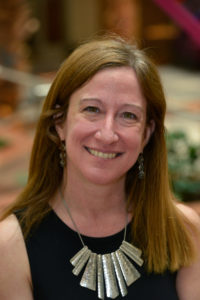R$ talks with Dr. Rebecca Keiser — NSF international chief pursues new collaborations with Canada
President Donald Trump's intention to slash key areas of his government’s research spending is inadvertently providing an incentive for new research collaborations between the United States and Canada.
The president’s fiscal 2018 budget, unveiled earlier this year, proposed massive cuts for climate science, medical research and energy projects across government, including major granting organizations such as the National Science Foundation (NSF), National Institutes of Health and the Environmental Protection Agency. Despite a reprieve in early May when Congress voted to mostly maintain current budgets for the rest of 2017, it’s uncertain whether the axe can be avoided again in 2018.
 Dr Rebecca Keiser, Head, Office of International Science & Engineering at the National Science Foundation
Dr Rebecca Keiser, Head, Office of International Science & Engineering at the National Science Foundation Photo: NSF/Sandy Schaeffer Photography
It’s that uncertainty that has prompted agencies such as the NSF to develop contingency plans, including talking with their Canadian counterparts on ways to better leverage each other’s investments when it comes to big-ticket research and scientific infrastructure.
RESEARCH MONEY’s consulting editor Debbie Lawes sat down May 31 with Dr. Rebecca Keiser, head of the NSF’s Office of International Science and Engineering, to discuss opportunities for new collaborations between our two countries. Keiser was a guest speaker in Ottawa that day at a Universities Canada roundtable discussion on the changing landscape of research in Canada, the U.S. and the U.K. (See related story)
R$: President Trump’s budget proposes cutting US$776 million, or 11%, of NSF’s budget in 2018. If approved by Congress next year, what impact will this have on the NSF and how are you preparing for that possibility?
Keiser: An 11% reduction means 11% fewer grants so we’re focusing on how we can look at that strategically. We’re going forward with almost all of our core programs; some other programs will be reduced such as fewer graduate research fellows. For instance we have an interdisciplinary program called the Innovations at the Nexus of Food, Energy and Water Systems and that’s reduced by about 60%. We’ll still have grants and it will still go forward but it will go forward in a fewer number of tracks with a fewer number of grants.
R$: Do those contingency plans include funding cuts to international collaborations or a change in how you approach these collaborations?
Keiser: With a budget like this we’re focusing even more on international partnerships because we need to have others bring money and resources to the table, including industry and foundation partnerships. We’re strategically thinking about how we can leverage these even better. For instance, it makes sense to think about working with Canada in quantum science because Canada is investing a billion dollars in this area. With a reduced budget for us and knowing that quantum is extremely important it makes sense to form the connections so our researchers can take advantage of some of the Canadian facilities and hopefully the Canadian researchers can also benefit from the US scientists’ knowledge.
R$: Have those discussions started taking place?
Keiser: They have. We have been talking to NSERC (Natural Sciences and Engineering Research Council). We haven’t formed any joint program or any mechanism for coordination as of yet but we’re talking and we’re looking at our respective capabilities. There are some other areas where we are talking seriously with NSERC, such as brain research. We have a new program at NSF called NeuroNex (Next Generation Networks for Neuroscience). It’s at the basic research level and it’s using engineering methodologies and tools to figure out how to better understand the brain. The other area where we already have a lot of collaboration and are looking at expanding with is Arctic research.
R$: At the individual researcher level, Canada and the US have a long history of collaboration. But has this same impetus existed at higher administration levels, particularly within the NSF?
Keiser: Not as much in the past but I see that changing. Where it makes sense is when it will benefit from a more strategic perspective. For instance, with quantum science when you’re looking at coordinating access to research facilities that would help our researchers and Canadian researchers by forming a formal structure for access to facilities, then that makes a lot of sense to collaborate. It also makes sense in the case of biodiversity research, when we want to help form an international community and we’re looking to collaborate with Canada in that area. By forming more of a top down collaboration in biodiversity research we can then use the different funding mechanisms to continue to bring the investigators together. So we help form this community and look then at forming further proposals for future calls.
R$: Are these discussions primarily between the US and Canada or are there also multilateral opportunities with other countries?
Keiser: For the NeuroNex collaboration it would be multilaterally. We’re talking with NSERC as well as Research Councils UK, the German Research Foundation (DFG) and Japan. The biodiversity effort is also multilateral. We have South Africa joining that partnership and we do collaborate with China and several other countries. Something like quantum science we would pursue bilaterally so we can better control the arrangement for something like access to facilities. Also, areas like quantum have such a strong national interest and security component so we have to be more careful.
R$: When looking at published research papers, US authors currently collaborate most frequently with authors from China. Canada’s biggest research collaborator is the US, but China is projected to displace the US within a few years. Do you see opportunities for new or strengthened multilateral collaborations between the US, Canada and China?
Keiser: In particular areas multilateral collaboration would make a lot of sense. We are very strategic in our collaboration with China. We are very careful about the areas in which we form these cooperative activities. Most of it is based in biological research and earth science research, including geosciences, where it makes sense to share data and learn from each other.
R$: The Canadian Institutes of Health Research would obviously partner with the National Institutes of Health, which is facing its own potential budget cuts, but do you see new collaborative opportunities between NIH and Canada’s Social Sciences and Humanities Research Council and the Canada Foundation for Innovation?
Keiser: With SSRHC we have a collaboration in social behaviour and economic sciences. A lot of it is still very bottom up and that’s absolutely fine. For the infrastructure, we had some really good meetings with CFI when we were here in March and we do coordinate with them already quite extensively in computer and information sciences and data infrastructure. We are talking to them about future collaboration, particularly related to the National Ecological Observatory Network (NEON). It’s a series of towers that we have around the US that collect ecological information and we would love to see if additional towers could be built in Canada so we could all share this great ecological information and data that we’re getting. We’ve also discussed with CFI ways in which we can strategize in future investments in telescopes and things like that because they are very expensive and we have to think about the next generation of these systems.
R$: Are a lot of these discussions happening in the US? I know several of our Cabinet ministers have been meeting with their American counterparts. Science minister Kirsty Duncan was in Washington in early May with a Canadian scientific delegation, including Nobel laureate Dr. Arthur McDonald.
Keiser: Yes, Dr. (France) Córdova, the president of the NSF met with her and I was there. It was a great meeting. They had met before at the Arctic Ministerial meeting that was held a few months ago but I think the great advantage to have Minister Duncan meet down here is it provides that driver. At the end of the meeting she was quick to ask what the next steps will be.
R$: What are the action items?
Keiser: Some I’ve already discussed such as biodiversity, quantum science and Arctic research. Another is to better coordinate on women in research and women programs. We already have several programs at NSF and have begun coordinating with Canada, particularly with NSERC to talk more about that. For Arctic research we talked about expanding these collaborations to more social science activities so we can understand the native cultures and preserving native cultures better.
R$: What actions can we expect to see first?
Keiser: One thing that we’ll hopefully see in the near future is related to this brain research solicitation. We’re working with Canada on what we call a “Dear Colleague” letter that would see us putting an announcement out to our research community saying NSF would welcome proposals to fund workshops and things like that and we encourage you to get Canadian collaborators as part of those workshops. The step would see them doing workshops together to come up with ideas for collaborative proposals. Then hopefully we do a coordinated solicitation after that. (NSF issued a similar Dear Colleague letter in 2015 related to collaboration with Canada on arctic research)
R$: Are both countries going to have to put money on the table to move these ideas forward?
Keiser: The first step for the Dear Colleague letter will be completely NSF-funded and then it’s going to be NSERC’s decision of course for the next step, which is whether we do a joint solicitation and whether there will be money.
Editor’s note: Questions and answers have been condensed and edited for clarity.
| Organizations: | |
| People: | |
| Topics: |
Events For Leaders in
Science, Tech, Innovation, and Policy
Discuss and learn from those in the know at our virtual and in-person events.
See Upcoming Events
You have 0 free articles remaining.
Don't miss out - start your free trial today.
Start your FREE trial Already a member? Log in
By using this website, you agree to our use of cookies. We use cookies to provide you with a great experience and to help our website run effectively in accordance with our Privacy Policy and Terms of Service.





